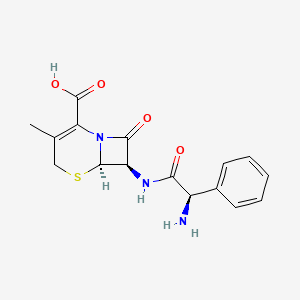Drug Information
Drug (ID: DG00419) and It's Reported Resistant Information
| Name |
Cephalexin
|
||||
|---|---|---|---|---|---|
| Synonyms |
Adcadina; Ades[prex; Alcephin; Alexin; Alsporin; Ambal; Aristosporin; Azabort; Bactopenor; Beliam; Biocef; CEX; Carnosporin; Cefablan; Cefacet; Cefadal; Cefadin; Cefadina; Cefalekey; Cefaleksin; Cefalessina; Cefalexgobens; Cefalexin; Cefalexina; Cefalexine; Cefalexinum; Cefalin; Cefalival; Cefaloto; Cefaseptin; Cefax; Ceffanex; Cefibacter; Ceflax; Ceforal; Cefovit; Celexin; Cepastar; Cepexin; Cephacillin; Cephalexine; Cephalexinum; Cephalobene; Cephanasten; Cephaxin; Cephin; Cepol; Ceporex; Ceporexin; Ceporexine; Check; Cophalexin; Domucef; Doriman; Durantel; Efemida; Erocetin; Factagard; Felexin; Fexin; Ibilex; Ibrexin; Inphalex; Karilexina; Kefalospes; Keflet; Keflex; Kefolan; Keforal; Keftab; Kekrinal; Kidolex; Lafarine; Larixin; Lenocef; Lexibiotico; Loisine; Lonflex; Lopilexin; Losporal; Madlexin; Maksipor; Mamalexin; Mamlexin; Medolexin; Medoxine; Neokef; Neolexina; Noveol; Novolexin; Nufex; Oracef; Oriphex; Oroxin; Ortisporina; Ospexin; Palitrex; Pectril; Prindex; Pyassan; Rilexine; Roceph; Rogevil; Sanaxin; Sartosona; Sencephalin; Sepexin; Servicef; Servispor; Sialexin; Sinthecillin; Sintolexyn; Sporicef; Sporidex; Syncl; Syncle; Synecl; Tepaxin; Theratrex; Tokiolexin; Uphalexin; Viosporine; Voxxim; Winlex; Zabytrex; Zozarine; Cefalessina [DCIT]; Cefalexin Scand Pharm; Cefalexin Sodium; Cefalexin generics; Cefalexin hydrate; Cefalexin monohydrate; Cefalexina Northia; Cefalexina Richet; Cephalex von ct; Cephalexin hydrate; Cephalexin monohydrate; Ceporex Forte; Durantel DS; Henina Oral; Panixine Disperdose; Roceph Distab; Lilly 66873; S 6437; SQ 20248; Cefa-iskia; Cefalexin (JP15); Cefalexin.H2O; Cefalexina [INN-Spanish]; Cefalexine [INN-French]; Cefalexinum [INN-Latin]; Cephalexin(USP); Cephalexin (anhydrous); Cephalexin 1-hydrate; Cephalexin 1-wasser; Cephalexin [USAN:BAN]; Cephalexin.H2O; Ceporexin-E; Cusisporina-Cefalox; Ed A-Ceph; KS-1134; Keflex (TN); Keftab (TN); L-Keflex; Panixine disperdose (TN); Sporidex (TN); Cephalexin, (6R-(6alpha,7beta))-Isomer; 7-(D-2-Amino-2-phenylacetamido)-3-methyl-delta (sup 3)-cephem-4-carboxylic acid; 7-(D-2-Amino-2-phenylacetamido)-3-methyl-delta3-cephem-4-carboxylic acid; 7-(D-alpha-Aminophenylacetamido)desacetoxycephalosporanic acid
Click to Show/Hide
|
||||
| Indication |
In total 1 Indication(s)
|
||||
| Structure |

|
||||
| Drug Resistance Disease(s) |
Disease(s) with Resistance Information Validated by in-vivo Model for This Drug
(1 diseases)
[1]
|
||||
| Target | Bacterial Penicillin binding protein (Bact PBP) | NOUNIPROTAC | [1] | ||
| Click to Show/Hide the Molecular Information and External Link(s) of This Drug | |||||
| Formula |
C16H17N3O4S
|
||||
| IsoSMILES |
CC1=C(N2[C@@H]([C@@H](C2=O)NC(=O)[C@@H](C3=CC=CC=C3)N)SC1)C(=O)O
|
||||
| InChI |
1S/C16H17N3O4S/c1-8-7-24-15-11(14(21)19(15)12(8)16(22)23)18-13(20)10(17)9-5-3-2-4-6-9/h2-6,10-11,15H,7,17H2,1H3,(H,18,20)(H,22,23)/t10-,11-,15-/m1/s1
|
||||
| InChIKey |
ZAIPMKNFIOOWCQ-UEKVPHQBSA-N
|
||||
| PubChem CID | |||||
| ChEBI ID | |||||
| TTD Drug ID | |||||
| VARIDT ID | |||||
| INTEDE ID | |||||
| DrugBank ID | |||||
Type(s) of Resistant Mechanism of This Drug
Drug Resistance Data Categorized by Their Corresponding Diseases
ICD-01: Infectious/parasitic diseases
| Drug Resistance Data Categorized by Their Corresponding Mechanisms | ||||
|
|
||||
| Key Molecule: Beta-lactamase (BLA) | [1] | |||
| Molecule Alteration | Expression | Inherence |
||
| Resistant Disease | Rhodobacter sphaeroides infection [ICD-11: 1A00-1C4Z] | |||
| Experimental Note | Discovered Using In-vivo Testing Model | |||
| In Vitro Model | Rhodopseudomonas sphaeroides strain DSM 160(Y) | 1063 | ||
| Rhodopseudomonas sphaeroides strain DSM158 | 1063 | |||
| Rhodopseudomonas sphaeroides strain DSM159 | 1063 | |||
| Experiment for Molecule Alteration |
Sodium dodecyl sulfate-PAGE assay | |||
| Experiment for Drug Resistance |
MIC assay | |||
| Mechanism Description | Thirteen strains of the gram-negative, facultative phototrophic bacterium Rhodobacter sphaeroides were examined fro susceptibility to beta-lactam antibiotics. All strains were sensitive to the semisynthetic penicillins ampicillin, carbenicillin, oxacillin, cloxacillin, and methicillin, but 10 of the 13 strains were resistant to penicillin G, as well as a number of cephalosporins, such as cephalothin, cephapirin, and cephalosporin C. A beta-lactamase (EC 3.5.2.6) with strong cephalosporinase activity was detected in all of the resistant strains of R. sphaeroides. With strain Y-1 as a model, it was shown that the beta-lactamase was inducible by penicillin G, cephalosporin C, cephalothin, and to some minor extent, cephapirin. | |||
References
If you find any error in data or bug in web service, please kindly report it to Dr. Sun and Dr. Zhang.
